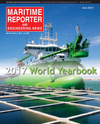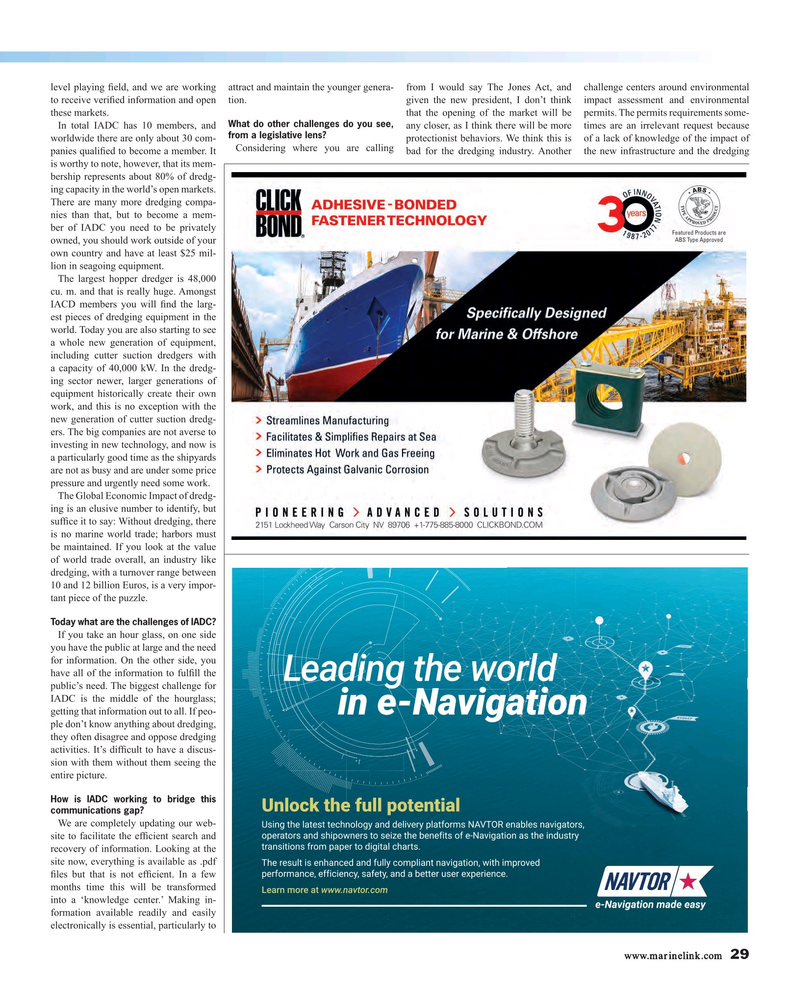
Page 29: of Maritime Reporter Magazine (June 2017)
U.S. Navy Quarterly
Read this page in Pdf, Flash or Html5 edition of June 2017 Maritime Reporter Magazine
level playing ? eld, and we are working attract and maintain the younger genera- from I would say The Jones Act, and challenge centers around environmental to receive veri? ed information and open tion. given the new president, I don’t think impact assessment and environmental these markets. that the opening of the market will be permits. The permits requirements some-
What do other challenges do you see,
In total IADC has 10 members, and any closer, as I think there will be more times are an irrelevant request because from a legislative lens?
worldwide there are only about 30 com- protectionist behaviors. We think this is of a lack of knowledge of the impact of panies quali? ed to become a member. It Considering where you are calling bad for the dredging industry. Another the new infrastructure and the dredging is worthy to note, however, that its mem- bership represents about 80% of dredg- ing capacity in the world’s open markets.
There are many more dredging compa- nies than that, but to become a mem- ber of IADC you need to be privately owned, you should work outside of your own country and have at least $25 mil- lion in seagoing equipment.
The largest hopper dredger is 48,000 cu. m. and that is really huge. Amongst
IACD members you will ? nd the larg- est pieces of dredging equipment in the world. Today you are also starting to see a whole new generation of equipment, including cutter suction dredgers with a capacity of 40,000 kW. In the dredg- ing sector newer, larger generations of equipment historically create their own work, and this is no exception with the new generation of cutter suction dredg- ers. The big companies are not averse to investing in new technology, and now is a particularly good time as the shipyards are not as busy and are under some price pressure and urgently need some work.
The Global Economic Impact of dredg- ing is an elusive number to identify, but suf? ce it to say: Without dredging, there is no marine world trade; harbors must be maintained. If you look at the value of world trade overall, an industry like dredging, with a turnover range between 10 and 12 billion Euros, is a very impor- tant piece of the puzzle.
Today what are the challenges of IADC?
If you take an hour glass, on one side you have the public at large and the need for information. On the other side, you have all of the information to ful? ll the public’s need. The biggest challenge for
IADC is the middle of the hourglass; getting that information out to all. If peo- ple don’t know anything about dredging, they often disagree and oppose dredging activities. It’s dif? cult to have a discus- sion with them without them seeing the entire picture.
How is IADC working to bridge this communications gap?
We are completely updating our web- site to facilitate the ef? cient search and recovery of information. Looking at the site now, everything is available as .pdf ? les but that is not ef? cient. In a few months time this will be transformed into a ‘knowledge center.’ Making in- formation available readily and easily electronically is essential, particularly to www.marinelink.com 29
MR #6 (26-33).indd 29 MR #6 (26-33).indd 29 6/9/2017 9:15:21 AM6/9/2017 9:15:21 AM

 28
28

 30
30
